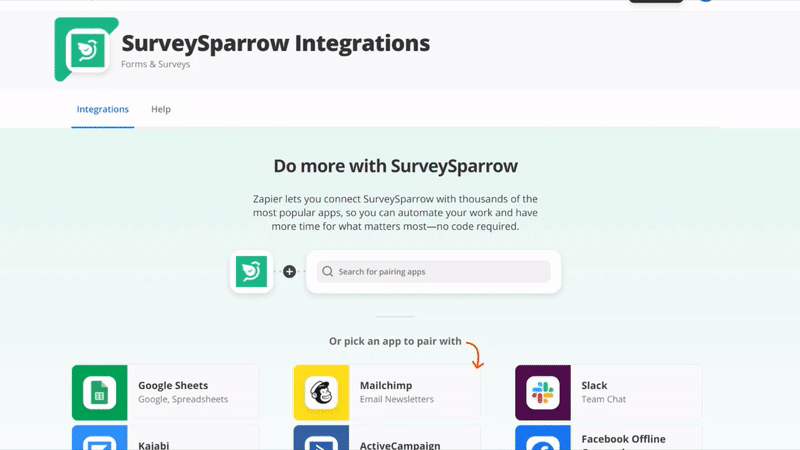Employee Experience
360 Degree Feedback Surveys: A Guide to Questions, Tools & Templates
Article written by Kate Williams
Product Marketing Manager at SurveySparrow
12 min read
19 September 2025

How can 360 degree feedback surveys help? 360 degree feedback surveys can be instrumental in addressing the lack of regular feedback in organizations and improving employee engagement.
Various studies tell a similar story:
- As per a Gallup study, one-half of the workforce receives feedback only a few times a year (or less).
- According to a feedback study by Joblist, the longer a person is at the company, the less likely they are to get reviews.
- Also, 33.4% of full-time employees said they’d prefer to receive more feedback.
- As per CEB, only 5% of managers felt they receive meaningful feedback.
- Even in this digital era, nearly 80% of businesses are still using traditional performance reviews.
The takeaway here is clear: whether you’re investing 10,000 hours or 21 days, it takes more than a magic number to learn a skill; you need frequent feedback. By implementing 360 degree feedback surveys, organizations can establish a frequent and unbiased feedback loop at all levels.
What is 360 degree feedback?
360 degree feedback is a comprehensive, multi-perspective feedback approach to get insights on an individual’s performance. It involves collecting feedback from various sources – such as peers, managers, direct reports, and even external stakeholders.
360 degree feedback surveys consist of carefully crafted questions that measure specific competencies, behaviors, and performance criteria. These questions are designed to gather honest and constructive feedback, which can then be used to create personal development plans and improve overall performance. Additionally, the feedback in a 360 degree feedback survey is always kept anonymous.
Why the 360 feedback process is better than traditional performance reviews
- 360 reviews don’t just focus on performance. They also focus on the employee’s behavior, skills and impact on their team.
- 360 degree reviews are anonymous. This means you can give and get candid feedback without fear of judgement.
- 360 degree feedback surveys have multiple sources. This lets you see a more realistic portrait of the employee and what they can do.
- Through a mix of open-ended questions and rating styles, the 360 feedback methodology provides more accurate data. This is helpful for promotions, transfers and role changes.
Here’s a 360 degree feedback example created with SurveySparrow:

Identify trends, patterns, and areas for improvement at a collective level. Sign up below to try SurveySparrow 360 for free.
14-day free trial • Cancel Anytime • No Credit Card Required • No Strings Attached
What questions should I ask in 360 degree feedback surveys?
Good question! You can easily customize this performance review form if you are short on time. But each organization has its own culture, skill sets and business needs. So we recommend putting some thought into your 360 degree feedback survey.
Here are five types of 360 degree feedback questions you can include in your survey. What’s more, you can customize them accordingly.
1. Leadership
There are three kinds of leaders in every group: the born, the made, and the ones that need guidance. To help you identify which is which, here are some questions that you can ask.
- Rate David’s understanding of his industry on a scale from 1-10.
- On a scale of 1-10, rate how well David handles conflicts within the team.
- How does David motivate others to achieve their goal?
- How often does David give feedback and coaching?
- Describe David’s relationships with his team members.
- How often does David reward his team?
- Please rate David on attitude and behaviour in high-pressure situations.
- How does David respond to negative feedback and criticism?
- Give an example of something that demonstrate David’s leadership.
- On a scale of 0-10, how would you rate David as a leader?
2. Motivation
Did you know that, as per Gallup, disengaged employees can cost their company 34% of their yearly salary? Yikes! That’s why we use motivation assessment questions. They help you find key motivators, track current engagement levels, and learn what you can do to improve it. Here are some sample questions.
- How excited are you to work on Monday? Say it with emojis. 😎🤯😭😵💫🥱🤩
- What motivates you at work?
- Pick any 5 words to describe our work culture.
- What can we do as an organization to help you?
- How would you rate our employee engagement activities?
- What improvements would you make to this company or your role?
- Does the company motivate you to go beyond your role?
- Do you have all the resources you need to work at your best?
- Okay, tell is what resources you need.
- On a scale of 1-10, how likely are you to recommend our company to others?
3. Performance
Performance assessment questions measure performance at 3 levels:
- The employee and their manager
- The team and its employees
- The employees and the organization as a whole
Your 360 degree feedback surveys should include a good mix of feedback from all of these levels. Here are a few sample questions to help you with that.
- What were Ali’s biggest achievements this quarter/year?
- Can you share an example of something Ali does well?
- Do you have any specific feedback on Ali’s strengths?
- What are the areas where Ali needs to improve?
- What do you think is the biggest motivation for Ali?
- How would you describe Ali’s approach to work?
- What are the 3 words you would use to describe Ali as a team member?
- Would you recommend Ali for [position name]?
- Rate Ali’s performance this year on a scale of 1-5.
- Which of Ali’s skills will be useful for the organization as a whole?
4. Problem-solving
According to Berke, there are 3 types of problem-solvers in every company:
- Logical: Critical thinkers, methodical approach, big-picture people, organized, good at strategic thinking
- Rapid: Multi-taskers, quick decision makers, intuitive, good in a crisis
- Spatial: Visualizers, systems thinkers, tech-savvy, good at spatial tasks and problems
But, what questions can help you measure problem-solving skills? Here are some examples.
- When Eva is faced with a problem, what does she do?
- While solving a challenge, does Eva ask for feedback from others?
- Does Eva look at problems from different perspectives?
- Can she come up with multiple solutions to a problem?
- Will Eva measure a new potential solution against a set standard?
- On a scale of 1-5, how often does Eva multi-task?
- There’s a sudden change of plan. How does Eva respond?
- A colleague has made a mistake and Eva finds out. How does she respond?
- What is the biggest challenge that Eva had to face at work?
- How does Eva reach a decision? Describe it in 5 steps.
5. Communication
Are you prepared for the challenges of the hybrid workplace? Always at top of the list is remote communication. This is why communication skills have become more vital than ever before – whether your staff work in-office, remotely or a mix of both. So here are some questions to help you test communication skills.
- Do you think Maria is an active listener?
- Rate Maria’s communication skills – verbal, written & visual – on a scale from 1-10.
- Does Maria present her views clearly and appropriately?
- How would you rate Maria’s presentation skills?
- Talk about a time Maria had to give bad news to a colleague.
- What would Maria do if she misunderstood an important communication?
- Rate Maria’s skill in simplifying a complex idea/problem
- A colleague’s not good at communicating. How does Maria handle it?
- Written or verbal communication: what is Maria better at?
- How would Maria react to a typo like thsi?
That wraps up this section. But here’s an additional point to keep in mind; timing is as important as the questions. So check out this primer on when to use 360 degree feedback.
360 degree feedback templates: Types
In general, a 360 feedback template comes as two types:
For employees
- The employee 360 feedback template is specifically tailored for individuals in non-managerial roles.
- The questions in this template assess the employee’s competencies, skills, communication style, teamwork, and overall performance.
- The feedback through this template helps employees:
– Gain insights into their strengths.
– Areas for improvement.
– Opportunities for growth.
For managers
- The manager 360 feedback template is designed specifically for individuals in managerial or leadership positions.
- The questions in this template typically focus on assessing the manager’s leadership skills, communication, decision-making, conflict resolution, and their overall effectiveness in managing and developing their team.
- The feedback through this template helps managers:
– Understand their impact on others.
– Identify areas where they can enhance their leadership abilities.
– Build stronger relationships with their teams.
What if you need a more focused 360 feedback questionnaire for one skill set? Check out our blog 9 Types of 360 Appraisal Format – and How to Use Them.
Tips for creating effective 360 degree feedback surveys
- Set a long-term goal. For example: “improving our work culture”, “creating a better rewards program”, “boosting productivity by 50%”.
- Choose the evaluators and employees. In 360 feedback, you can limit the process to certain parties. For example, the employees and their peers, employees and their supervisors, and so on.
- Select the approvers. Approvers are the people who review the employee along with the evaluators. They also approve the list of evaluators as well as the final report.
- Inform your employees. Educate them about the purpose of the 360 degree feedback survey.
In addition, here are a few tips you can use to increase your responses.
- Keep the questions simple and clear.
- Avoid corporate jargon.
- Use an active voice.
- Personalize with your employee’s name, brand color and fonts.
- Make customization and automation easy with 360 degree feedback software.
That takes us to…
Choosing a 360 degree feedback tool: 5 key features to look for
From creating forms to generating reports, 360 review software like SurveySparrow makes performance evaluations more efficient than ever before. But there are 5 critical features you must look for while choosing a 360 degree feedback software. Let’s review.
1. A customization module with:
- Survey design & branding capabilities
- Ability to set minimum scores
- Email customization
- Diverse survey sharing options
2. A dedicated employee portal with:
- Feedback tracking
- Task management
- Evaluation status tracking
- Self, Peer, Manager & Custom reviews

3. A built-in reporting module with:
- Auto-generated reports
- Report customization
- Ability to select various competencies for analysis
- A section in the employee’s Personal Development Plan for the reviewer to add their comments
4. Survey automation capabilities with:
- Ability to set recurring surveys
- Scheduling surveys
- Cut-off dates
- Automatic reminders
- Automatic scoring for each survey section

5. Finally, you need security features like these:
- Custom SSL
- IP whitelisting
- Domain customization
- Audit logs
- HIPAA enablement
- Account access management
What are the benefits of 360 degree feedback surveys?
- Increased engagement: Many studies show that employees disengage when they feel ignored. 360 feedback software provides two antidotes for this problem – appreciation for their work, and suggestions for improving their skills.
- A wider lens: Let’s use an example: your employee is a superb marketer. Her team admires her for her work ethic but her peers outside the team take a different view. Why? Because they aren’t as involved with her work. 360 reviews combine these perspectives to show how she is perceived within and outside the team.
- Team development: 360 degree performance reviews enable two-way feedback between all team members. This helps teams develop a better sense of accountability and motivates them to up their game.
- Career development: Through the 360 feedback system, your employees get plenty of chances to learn their strengths, and where they need to improve. What’s more, each employee gets a personal development plan (PDP) – a kind of how-to guide for improving their performance.
Wrapping Up
Goodbye, spontaneous office chats? New hybrid work models and flat work structures are now the norm. That’s why more and more companies are turning to annual and even quarterly 360 degree feedback surveys.
For the best results, we recommend a system of 360 surveys with meeting ratings and weekly check-ins. Why? Because no one wants to wait months to give an urgent feedback! When combined, these surveys create a constant feedback loop that builds up to an effective employee, better teams and ultimately, a stronger company.

Get upto 40% more responses on your employee surveys. Start your free trial today!
Kate Williams
Excels in empowering visionary companies through storytelling and strategic go-to-market planning. With extensive experience in product marketing and customer experience management, she is an accomplished author, podcast host, and mentor, sharing her expertise across diverse platforms and audiences.
Related Articles

Employee Experience
What Is Employee Engagement? The 6th Answer Will Surprise You!
12 MINUTES
26 November 2018

Employee Experience
12 Top HRMS Software: The 2024 Edition
14 MINUTES
26 November 2021

Employee Experience
Top 5 Factors Driving Workplace Satisfaction
7 MINUTES
16 December 2020

Employee Experience
Ultimate Guide To Leadership Assessment
15 MINUTES
26 February 2021


